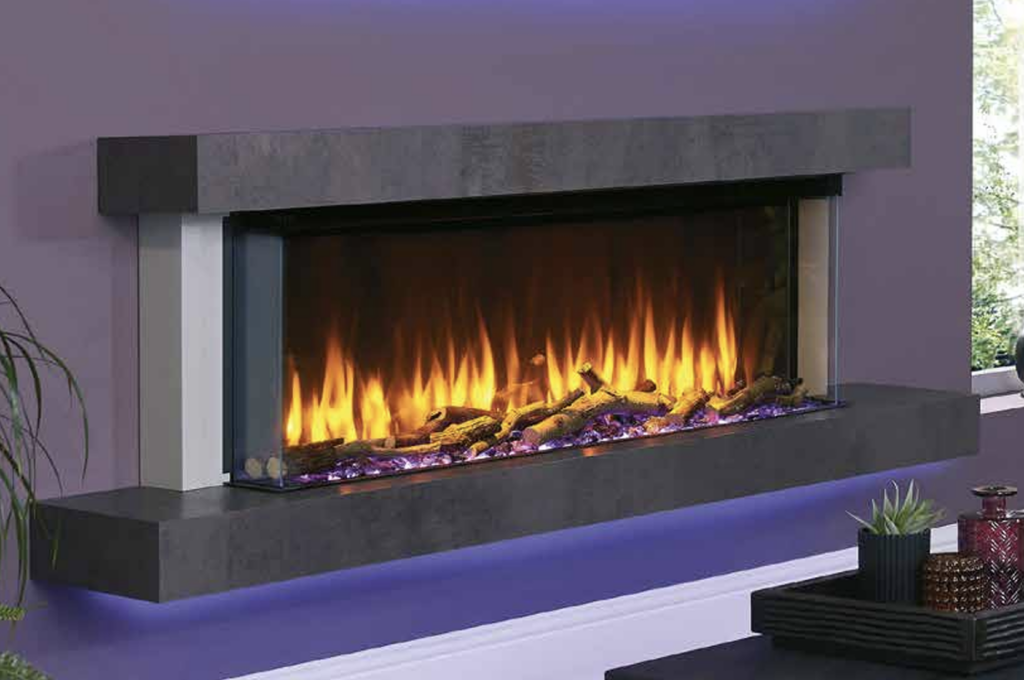Electric used to be the less preferable choice when looking for a fire – with gas and wood-burning stoves being the most popular front runners. Things have changed somewhat. It’s not to say stoves or gas fires have fallen out of favour, far from it – but more people are starting to realise the benefits that come with an electric fire.
With the growing threat of climate change, there is more focus than ever on being sustainable and reducing our reliance on fossil fuels. With electric there are no emissions at the point of use – although incredibly efficient, with gas and wood, there are some emissions inevitably released when warming a room. But electricity does not magically appear – it still needs to be generated by a power station, which will still emit carbon – but thanks to growing renewable energy, around 40-50% of the UK’s electricity came from zero-carbon sources, such as wind, solar, hydroelectric.
Inefficient non-Ecodesign stoves and open fires emit higher levels of pollution, including deadly PM2.5 – which can cause significant health issues due to poor local air quality. PM2.5 increases health issues such as heart disease, asthma and other health issues.
PM2.5, also known as fine particulate matter, refers to particles or liquid droplets in the air that have a diameter less than 2.5 micrometres across (about 3 per cent of the diameter of a human hair). Some PM2.5 is naturally occurring, such as dust and sea salt, and some is manmade, such as particulates from vehicle exhausts and from burning.

One major advantage of electric fires is there is no waste heat – 100% of the electric used will be used for heat. Compare that to an open fire where around 80% of the heat produced will disappear up a chimney. Efficiencies don’t end there – many electric fires and many found in the Charlton & Jenrick electric range incorporate LED lights – they only use 10% of the watts that traditional incandescent lights use to produce the same amount of light. They also last around 40 times longer!
Buying 100% Renewable Electricity?
Opting for 100% renewable energy will enhance your home’s green credentials. If you buy a 100% renewable tariff from a supplier, which is perfect if you want your electric fire and other appliances in your home to be renewable, but be aware it doesn’t change the actual electricity that comes into your home. But it does alter what part of the energy market you are paying for. There is no exact definition of what a renewable tariff is – and energy companies take a range of approaches. To make an environmental claim or statement about their energy source, they must show that the environmental gain is due to the customer’s chosen tariff.
The energy supplier must also publish its fuel mix and the environmental benefit of the tariff, and they must be able to prove where the renewable energy has come from – by having enough certificates. Currently, for an energy supplier to sell 100% renewable energy, the firm must buy enough certificates for renewable energy to match what customers on the tariff use over a year.
Certificates?
A certificate in relation to renewable energy proves that a megawatt hour of renewable energy has been generated. They come in two forms:
1. REGO – Renewable Energy Guarantees of Origin if they’re for electricity generated in the UK
2. GoOs – Guarantees of Origin if they’re for electricity generated in the EU.
These certificates don’t actually prove that an energy company has made any renewable electricity itself or purchased renewable electricity directly from a generator. Providers can buy them without buying the associated renewable electricity.
Over time, there will be a greater percentage of energy being derived from renewable methods, which is essential to help combat climate change. We are not there yet, but we are getting closer as research and development evolves and develops.








